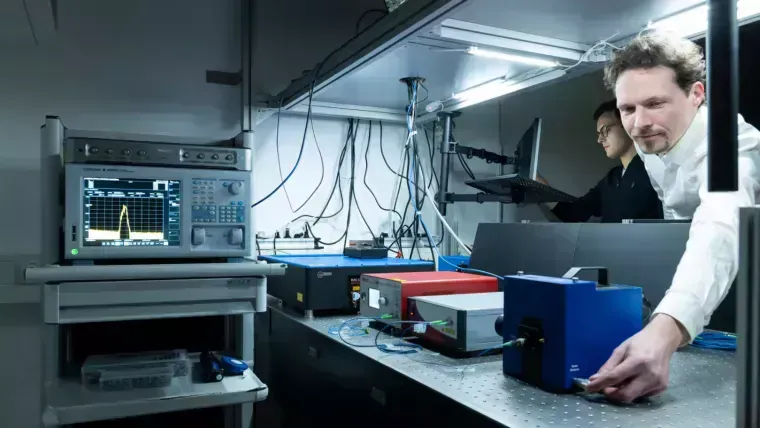
- Light
Published: | By: Lavinia Meier-Ewert (Leibniz-IPHT); English translation by Gleb Chupakhin
Researchers of the Jena Leibniz Institute of Photonic Technology (Leibniz-IPHT) and the Friedrich Schiller University Jena have developed a new technology that could greatly reduce the high energy needs of AI systems in the future. The technique uses light for neural computation and is modeled after the neural networks of the human brain. Data processing will not only become more efficient using this technology, but perhaps also many times faster – all while using considerably less energy than conventional systems. The researchers’ technique was published in the well-known journal “Advanced Science” and presents new possibilities for environmentally friendlier AI applications as well as for new methods of intelligent microscopy and computer-free diagnostics.
Artificial Intelligence (AI) is a key factor for the advancement of biotechnology and medical procedures, from cancer diagnostics to the development of new antibiotics. However, the ecological footprint of large AI systems is substantial. For example, the training of large language models like ChatGPT-3 requires several gigawatt-hours of energy—a quantity sufficient to power an average nuclear power plant at full capacity for hours.
Prof. Dr. Mario Chemnitz, recently appointed as Junior Professor for Intelligent Photonic Systems at Friedrich Schiller University Jena, and Dr. Bennet Fischer from the Jena Leibniz Institute of Photonic Technology (Leibniz-IPHT), along with their international team, have found an innovative way to potentially develop energy-efficient computing systems that forego extensive electronic infrastructure. They leverage the unique interactions of light waves in optical fibers to create an advanced artificial learning system.
A Single Optical Fiber
What sets their system apart is the utilization of a single optical fiber instead of traditional computer chips with thousands of electronic components. This fiber can handle the tasks of a variety of artificial neural networks—and all at the speed of light. "We are emulating the computing power of various neural networks with a single optical fiber," explains Mario Chemnitz, who also leads the junior research group "Smart Photonics" at Leibniz-IPHT. "This system enables the rapid and efficient processing of massive amounts of data in the future by harnessing the unique physical properties of light."
Identifying Illness Using the Voice
A closer examination of the functionality reveals how the blending of light frequencies transfers information: data, whether it's pixel values from images or frequency components of an audio track, is impressed upon the color channels of ultrashort light pulses. These light pulses carry the information through the fiber, where they are combined, amplified, or attenuated in various ways. New color combinations at the output of the fiber now allow predictions about the nature or context of the processed data. For example, specific color channels may reveal what objects are present in images or whether there are signs of illness in a person's voice.
A typical example of machine learning is the recognition of various digits from thousands of handwriting styles. Mario Chemnitz, Bennet Fischer, and the team from the National Institute of Scientific Research (INRS) in Québec applied their method to impress images of handwritten single digits onto light signals and classify them through the optical fiber. The alteration of their color composition generates a unique color spectrum at the end of the fiber—a "fingerprint" for each digit. After training, the machine can analyze and recognize digits from new handwriting styles with significantly lower energy consumption.
Color Hue Identifies Data
"Simplifying, one can imagine that pixel values are translated into different intensities of primary colors—meaning a bit more red or less blue depending on the value," explains Mario Chemnitz. "In the fiber, these primary colors then blend into the entire spectrum of the rainbow. The hue of our mixed lilac in the rainbow, for example, now reveals a lot about the data our system has processed."
The team has also tested their approach in a pilot study for the diagnosis of COVID-19 infections through voice samples, achieving accuracy surpassing the best existing digital systems. "We are the first to demonstrate that such a colorful interplay of light waves in optical fibers enables direct classification of complex information—without the need for additional intelligent software," states Mario Chemnitz.
Mario Chemnitz has been serving as Junior Professor for Intelligent Photonic Systems at Friedrich Schiller University Jena since December 2023. Since his return from the INRS in Canada in 2022, where he worked as a postdoc, Chemnitz has been leading an international team at Leibniz-IPHT in Jena. With support through the Nexus funding of the Carl Zeiss Foundation, the team is exploring the possibilities of nonlinear optics. The objective is to develop intelligent sensor systems and microscopes without the need for computers, as well as methods for green computing.
Original publication with video abstract:
B. Fischer, M. Chemnitz, Y. Zhu, N. Perron, P. Roztocki, B. MacLellan, L. Di Lauro, A. Aadhi, C. Rimoldi, T. H. Falk, R. Morandotti: Neuromorphic Computing via Fission-based Broadband Frequency Generation. Adv. Sci. 2023, 10, 2303835. https://doi.org/10.1002/advs.202303835External link